mobile View, to the German Version tap the flag


- Balearics
- Autonomous Region of Spain
- 1232–1343 Kingdom of Majorca
- 1344–1714 Kingdom of Majorca as a part of the united crown of Aragon
- own names:
– Spanish: Islas Baleares
– Katalan: Illes Balears
• Flag
• Historical and other Flags
• Meaning/Origin of the Flag
• Coat of Arms
• Historical Coats of Arms
• Meaning/Origin of the Coat of Arms
• Map of the autonomous regions of Spain
• Numbers and Facts
• History
• Origin of the Country's Name
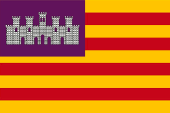
since 1983,
Flag of the Balearic Islands,
ratio = 2:3,
Source, by: Flags of the World






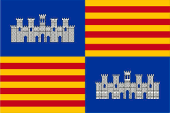
1229–1715,
Flag of the Kingdom of Majorca,
ratio = 2:3,
Source, by: Wikipedia (ES)



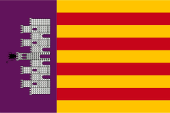
1978–1983,
unofficial flag of the Balearic Islands,
ratio = 2:3,
Source, by: World Statesmen




Majorca:

since 1983,
Flag of Majorca,
ratio = 2:3,
Source, by: Flags of the World





Menorca (Minorca):
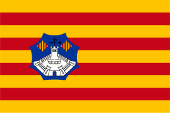
since 1983,
Flag of Menorca,
ratio = 2:3,
Source, by: Flags of the World



Ibiza (Eivissa):
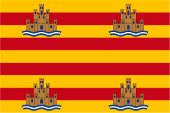
since 1983,
Flag of Ibiza,
ratio = 2:3,
Source, by: Wikipedia (ES)



Formentera:
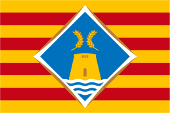
since 2010,
Flag of Formentera,
ratio = 2:3,
Source, by: Wikipedia (ES)




The current flag of the Balearic Islands was officially introduced on 25th of February 1983. It shows four horizontal red stripes on a golden background and a purple upper corner in which a castle can be seen. The motif is reminiscent of the historical flag of the Kingdom of Mallorca. In 1228, James I, King of Aragon, conquered the island of Mallorca, and by 1232 the conquest of the Balearic Islands was complete. James I incorporated the archipelago into his domain as the Kingdom of Mallorca, and he was the first king of Mallorca. The coats of arms that have survived from this time show in quad four vertical red stripes on a golden background (Aragon) and a blue field with a white castle in it, which is also reflected on flags or banners, sometimes with vertical and sometimes with horizontal red lines. This castle is the castle of Palma, the Almudaina Castle Palace, also called Almoraina. It has been a fortified place in Palma since Roman times, in a strategic position. The Arabs (Moors) built their residence, the Alcazar Palace, here in the 10th century. Under King James II, the Alcazar was converted into the royal castle – today's Almudaina Palace – from 1305 to 1314. It still serves as the Spanish king's residence when he is in Mallorca. In 1269, King James I allowed the University of Palma to use its own flag and its own coat of arms. When he died in 1276, he bequeathed his kingdom to his two sons. Aragon remained with his elder son Peter III, while his younger brother James II inherited the kingdom of Mallorca, plus the Counties of Roselló (Roussillon) and Cardanya (Cerdagne) and the Dominion of Montpeller (Montpellier). His capital became Perpinyá (Perpignan) in Roselló. He took over his father's coat of arms, but the historical images of coats of arms or banners show a slight difference. The number of red bars decreased to three. Flags or coats of arms with this image are now called "tribarrada". The reasons for this are not known. Either no importance was attached to counting the Aragonese bars at that time, or James II was keen to create his own heraldry, different from that of his brother. Another heraldic image associated with the Kingdom of Mallorca is the usual coat of arms of Aragon with the four red vertical bars on gold, but with a blue slanting bar superimposed. It does not appear in early historical images, but in the Renaissance, as a heraldic emblem on the occasion of the funeral of Charles I of Spain in 1558. This is also puzzling, especially because this heraldic image is now considered the coat of arms of the Kingdom of Mallorca. But, it was customary in heraldry to mark non-legitimate side and bylines of a family excluded from inheritance in the coats of arms by a so-called "bastard thread" placed diagonally across the family coat of arms. Jacob II was the younger son, Peter III the elder. Peter's dynasty will have done all they could to exclude James and his successors from the succession (especially in Aragon). In fact, they did not even recognise the possession of James II and always disputed his inheritance. How this coat of arms could become the coat of arms of the Balearic Islands in 1978 is also a mystery. King Sancho, who ruled from 1311 to 1324, is associated with another legendary flag that he is said to have created. It showed the four red bars on gold and in perpendicular alignment to them, but at the leech or top a broad blue bar across the entire width, with a white castle in it. This flag, probably an invention of more recent times, was then chosen as a model when it came to designing a flag for the newly to create autonomous region of the Balearic Islands in 1978. Under the government of General Franco (1936-1975), all regional flags were banned. After Franco's death (1975), regional flags were reintroduced or newly created, also in the Balearic Islands, although unofficially at first, because the Balearic Islands did not have autonomous status until 1983. In 1978, a flag was adopted that resembled the Sancho flag, only the bar with the image of the castle appeared in purple instead of blue. When the Balearic Islands gained autonomy in 1983, the current flag was introduced and the flag previously in force was officially adopted by the island of Mallorca. On this flag, an angel with a crook appears on the battlements of the central tower. This angelic figure, which is actually carved on the outside of the main tower, now appears mostly in black on the flags of Mallorca, but also in white and some flags do not show it at all.
Source: Wikipedia (ES),
Flags of the World,
teapartybalear.blogspot.com,
Volker Preuß

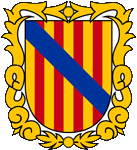
since 1984,
Coat of arms of the Balearic Islands,
Source, by: Wikipedia (ES)


Coat of arms of the Kingdom of Majorca,
Source, by: fuenterrebollo.com

Coat of arms of the Kingdom of Majorca,
Source, by: eapartybalear.blogspot.com

Coat of arms of the Kingdom of Majorca,
Source, by: Wikipedia (ES)

The current coat of arms of the Balearic Islands was officially introduced on 21.11.1984. The shield shows the arms of Aragon from 1150 (four red bars on gold) supplemented by a blue slanting bar. The colours red and gold are said to be due to the influence of the Pope, as the old kingdom of Aragon and the county of Barcelona were fiefs of the Holy See, and therefore used the colours of the city of Rome. This coat of arms does not appear in early historical illustrations, but it did in the Renaissance, as a heraldic emblem on the occasion of the funeral of Charles I of Spain in 1558. This is also puzzling, especially because this coat of arms is now considered the coat of arms of the Kingdom of Mallorca. But, it was customary in heraldry to mark non-legitimate side and collateral lines of a family excluded from inheritance in the arms by a so-called "bastard thread" placed diagonally across the family coat of arms. Jacob II was the younger son, Peter III the elder. Peter's dynasty will have done all they could to exclude James and his successors from the succession (especially in Aragon). In fact, they did not even recognise the possession of James II and always disputed his inheritance. How this coat of arms became the coat of arms of the Balearic Islands in 1978 is a mystery. In 1228, James I, King of Aragon, conquered the island of Mallorca, and by 1232 the conquest of the Balearic Islands was complete. James I annexed the archipelago to his domain as the Kingdom of Mallorca, and was the first king of Mallorca. The coats of arms that have survived from this time show four vertical red stripes on a golden background (Aragon) and a blue field with a white castle in it. This castle is the castle of Palma, the Almudaina Castle Palace, also called the Almoraina. It has been a fortified place in Palma since Roman times, in a strategic position. The Arabs (Moors) built their residence, the Alcazar Palace, here in the 10th century. Under King James II, the Alcazar was converted into the royal castle - today's Almudaina Palace - from 1305 to 1314. It still serves as the Spanish king's residence when he is in Mallorca. In 1269, King James I allowed the University of Palma to use its own flag and coat of arms. When he died in 1276, he bequeathed his kingdom to his two sons. Aragon remained with his elder son Peter III, while his younger brother James II inherited the kingdom of Mallorca, plus the counties of Roselló (Roussillon) and Cardanya (Cerdagne) and the lordship of Montpellier. His capital became Perpinyá (Perpignan) in Roselló. He adopted his father's coat of arms, but the historical images of coats of arms or banners show a slight difference. The number of red bars was reduced to three. Flags or coats of arms with this image are now called "tribarrada". The reasons for this are not known. Either no importance was attached to counting the Aragonese bars at the time, or James II was keen to create his own heraldry, different from that of his brother.
Source: Wikipedia (ES),
teapartybalear.blogspot.com,
Volker Preuß

The autonomous regions of Spain:
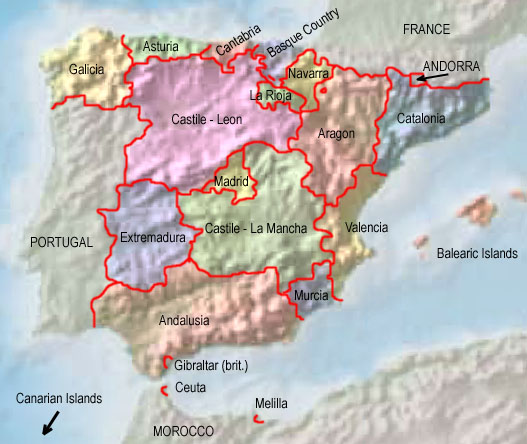
Source: Freeware, University of Texas Libraries, modyfied by: Volker Preuß

Area: 1.927 square miles
Inhabitants: 1.176.659 (2022), thereof ca. 5% Germans, ca. 2% British
Density of Population: 610 inh./sq.mi.
Capital: Palma (Palma de Mallorca), 415.940 inh. (2022)
official Language: Spanish (Castilan), Catalan
other Languages: Dialects of the various islands
Currency: Spanish (Euro) currency
Time Zone: GMT + 1 h
Source: Wikipedia (DE)

4th millenary B.C. · settlement of the islands
11th–7th cent. B.C. · the islands are a colony of Phenicia
3th cent. B.C. · the islands are a colony of Cathago
123 B.C. · consul Quintus Caecilius Metellus conquers the islands (called Balearides) for the Roman Empire, they come later to the province Hispania Tarraconensis, settlement by Baetiks from the south of the Iberian Peninsula, foundation of the towns Palma and Polentia on Mallorca Island
425 A.D. · the Vandals under Gunderich conquer the islands
560 · the East Roman Empire Reich (Byzantium) conquers the islands
798 · the Arabs conquer the Balearic Islands, to the Emirate of Córdoba (since 929 Arabian Califate of Cordoba under the dynasty of the Omajjads)
1010 · overthrow of the Omajjads dynasty, to 1040 disintegrates the empire in some arabian kingdoms (Malaga, Algeciras, Granada, Cordoba, Toldeo, Valencia, Zaragoza, Denia, Murcia and Badajoz), the Balearic Islands come to the Kingdom Medina bu Taral (Valencia)
1220 · the Balearic Islands separate from Medina bu Taral and they are ruled by an own moresque king
1228 · Jacob I. of Aragon conquers Majorca
1232 · James I of Aragon conquers Menorca and Ibiza and founds the Kingdom of Majorca
1232–1343 · times of the rule of the Kings of Mallorca (Jacob I., Sancho and Jacob II.)
1276 · Death of King James I of Aragon, the inheritance goes to his two sons, Aragon goes to his elder son Peter III, his younger brother James II inherits the Kingdom of Majorca and in addition the counties of Roselló (Roussillon) and Cardanya (Cerdagne) and the Dominion of Montpeller (Montpellier), capital of the Kingdom of Majorca becomes Perpinyá (Perpignan) in Roselló
1343 · King Peter IV of Aragon conquers the Kingdom of Mallorca in the Wars of Peter (Wars of Succession), the Kingdom of Mallorca remains as a part of the united Crown of Aragon until 1714
1469 · marriage of king Ferdinand II. of Aragon with Isabella, the throne heiress of Castile-Leon
1479 · coronation of Ferdinand II. and Isabella I. to kings of Spain
1516 · official unification of Aragon and Castile-Leon, but Aragon withholds important privileges
1609 · king Philipp III. of Spain banishes the last Muslims (Moresques) out of the country
1701–1714 · Spanish succession war, United Kingdom occupies Minorca Island in 1708, Aragon positiones itself at the side of Austria, after the defeat loss of the privileges, end of the independent kingship of the United Crown of Aragon, Catalonia, the Balearic Islands and Valencia become outsourced as Spanish provinces
1713 · Peace of Utrecht, Spain cedes Minorca official to United Kingdom
1783 · Peace of Versailles after the American Independence War, United Kingdom has to give Minorca back to Spain
1798–1802 · United Kingdom occupies Minorca Island again
1808–1812 · the Balearic Islands are occupied by French troops
1931 · autonomy statute for the Balearic Islands is proposed for the first time
1936–1939 · Spanish Civil War, the Balearic Islands are from the beginning on in the hands of the troops of General Franco and become an important base in the struggle against the socialistic central government
1st of March 1983 · the Balearic Islands get the statute of autonomy within Spain (former province of Palma), establishment of the "Autonomous Community of the Balearic Islands"
Source: Wikipedia (ES),
World Statesmen,
RetroBib Retrobibliothek,
Volker Preuß

The name of the archipelago of the Balearic Islands has its roots in the antiquity. The inhabitants of the islands were famous as very skilled stone-hurlers which served as mercenaries on the battlefields of the antiquity. In the name of the Balearic Islands (in the antiquity Balearides) is thats why to recognize the Greek word "ballistics". Older German lexica call the islands "Hurlers Islands" too.
Source: RetroBib Retrobibliothek, Volker Preuß


![]()



























